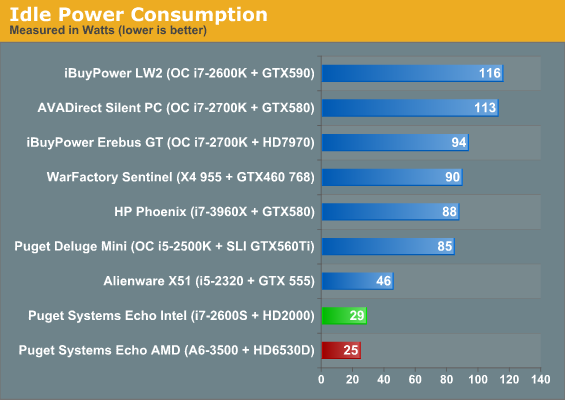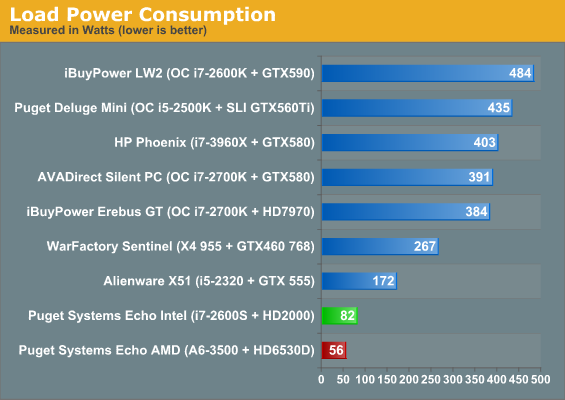Puget Systems Echo: Intel and AMD Showdown at 65 Watts
by Dustin Sklavos on March 21, 2012 2:35 AM EST- Posted in
- Systems
- AMD
- Intel
- Mini ITX
- Sandy Bridge
- Llano
- boutique
- Mini-Tower
Build Quality and Part Selection
Given the small nature of the Antec ISK-110 enclosures Puget Systems employs for their Echo I systems, it's not going to be much of a surprise that there's really only so much they can do to make build quality stand out. For what it's worth, the systems are put together as well as one can expect. Both use stock coolers from AMD and Intel, but given the low TDPs of the two processors (as well as the cramped confines of the enclosure) these coolers are never given much of a workout. Cabling is routed as well as can be expected, and Puget Systems filled both of the 2.5" drive bays. These systems really are packed to the gills.
.jpg)
This is a good time to bring up one of the ways Puget Systems distinguishes themselves from other boutiques, though. If you opt to configure a system on their site, you're going to find the number of available components substantially lower than you will from any other boutique. This has to do with their validation procedures; Puget is extremely picky about the parts they include in the desktops they ship and while I'd like to see this confidence reflected in a longer warranty than just one year, I've seen enough of their data (and their customer feedback) to corroborate their claims. It's the reason you only see Intel SSDs in their systems, for example.
It's also part of the reason why our AMD system is fighting a bit of an unfair fight, a point we brought up with Puget Systems and one they recognized. It's well known that Llano will use all the memory bandwidth it can get its hands on, while Sandy Bridge is much less sensitive. Puget hasn't qualified any 8GB DDR3-1600 DIMMs for deployment in any of their builds, and so they erred on memory capacity instead of speed. In conversations via e-mail, they even admitted this was probably a mistake in this instance. The problem is that they also don't offer any 2GB or 4GB DDR3-1600 DIMMs for the AMD-based system, either, when they do have 4GB DDR3-1600 DIMMs qualified for other builds.
As an aside, I did contact Puget Systems and ask why their parts warranty period was so limited compared to other boutiques, and their rationale is actually a fairly sound one: there's just no guarantee that the replacement parts will continue to be available for three years, given how fast hardware turns over in this industry. They don't feel a standard three year warranty is something they can in good conscience live up to, and so the three year warranty upgrade they offer is actually in place to cover the costs of offering brand new kit to replace defunct hardware should the need arise.
Heat and Noise
While I wasn't expecting too much in the way of thermal issues even with the stock cooling, I felt like noise could've gone either way when I pulled the two Echo systems out of their boxes. The side panel above the motherboard is completely ventilated, allowing fresh air to circulate inside the enclosure. That's great for cooling, but does absolutely nothing to muffle noise.
Thankfully, the circulating cool air does wonders to keep either heatsink's fan from having to work particularly hard. Neither system is actually audible while running unless you put your ear up to the open side; any kind of ambient noise in the room will muffle them. The result is that both systems never see temperatures above the low 60C on the cores, and noise is essentially a non-issue unless you're looking for a "silent" system.
Power Consumption
Most of the test results up to this point have been fairly predictable, but power consumption was a big surprise and a pretty stunning upset. Rather than build you up to it, I'll just show you.


At both idle and load, the AMD-based system beats the Intel-based one. Look at the load numbers in particular; the A6-3500 is able to beat the Intel Core i7-2600S by nearly thirty watts. I expected both to be frugal, but the A6-3500 is actually performing well under its rated wattage.


_thumb.jpg)
_thumb.jpg)
_thumb.jpg)
_thumb.jpg)
_thumb.jpg)
_thumb.jpg)








62 Comments
View All Comments
ReverendDC - Monday, March 26, 2012 - link
Folks:This was a review of two pre-configured systems. In the end of the article, the author specifically states that there are far more powerful AMD CPUs available in the same power envelope, but they are not readily available, even on NewEgg, and that the manufacturer doesn't add them in as an option.
If I were an AMD fan (and I am...), I would be ecstatic that my admittedly lower-end CPU/GPU combo knocked out the MUCH more powerful i7 CPU/GPU combo for overall usefulness. I believe that competition is absolutely necessary in the CPU space - just look and see how much Intel is sitting on their laurels right now without a really good challenger to their CPU dominance right now, and then look how much work they are putting into the GPU side of things now that AMD has eaten their lunch in that arena. How could you claim that this article was written by an Intel fellow when the parting thought was that he would go with the AMD solution for a system such as this (notebook, HTPC)?
In addition, the author basically chastises the manufacturer for not making better parts available that would take advantage of the AMD's love of memory without even coming close to breaking the power consumption limit.
Come on, guys. We all know that the CPU side of AMD is not the reason people buy APUs. We all know that, until AMD drops the new NetBurst architecture they are trying to push (Bulldozer) and realize that, if Intel failed with that strategy, AMD may just go bankrupt using it, that Intel will DESTROY AMD on the CPU side. We also know that, even with Ivy Bridge, there is a good chance that the GPU side will STILL belong to AMD, even at current Llano builds (there is a previous article from Anand previewing the new Ivy Bridge GPU). There was not a single shock in this article. Why argue well-documented facts at this point....
Thanks for your time.
djfourmoney - Thursday, April 12, 2012 - link
What do mean they have qualified 1600Hz memory for the Llanos? Tom's already ran its own testing and PNY Xlr8 are the best given the price, availability and performance.Given faster memory the Llano would put a further smack down on Sandy Bridge graphics and run BF3!
These APU's are perfectly suited for HTPC use, especially given the price of cut down i3's (G-series).
I was wondering if this would run on the 90W power brick Antec gives you. I have A6-3500 waiting for a motherboard and memory. I sort of want to downsize my HTPC which uses a Sonta III case currently. But that would mean buying at least one external device and leaving my poor PCI TV Tuners out to lunch.
All total it would add $80 for the Antec case, $45 for a used 650HD USB Combo Tuner (ATI has better PQ chips!) and $15 for the ASRock board over the Mico-ATX version.
Oh well... Serious Budget Upgrade so I'll likely stick to the original plan. Thanks for the Review.